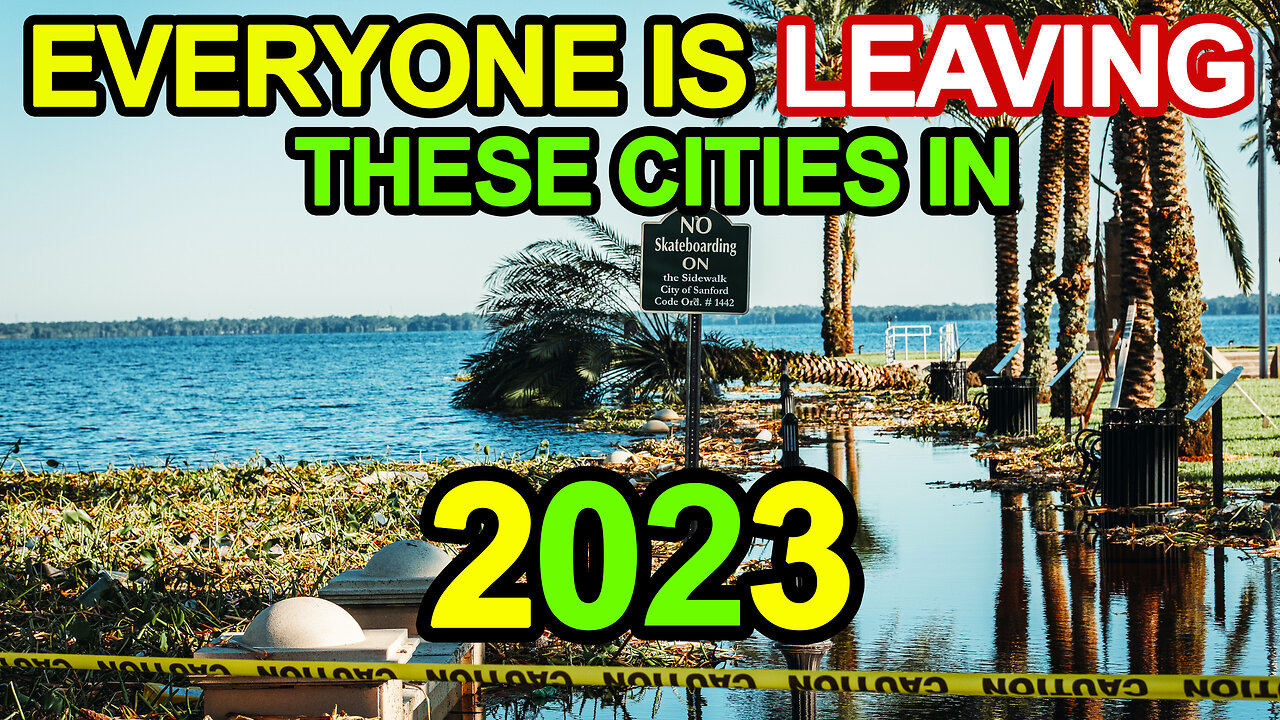Premium Only Content

Top 10 Cities EVERYONE is LEAVING in United States.
From once-thriving urban centers plagued by crime, to cities notorious for their terrible weather, it's clear that not all places are destined to flourish. In this video, we'll explore the top 10 American cities that people are leaving in droves, seeking a better way of life elsewhere. Driven by various factors such as high unemployment rates, deteriorating public services, inadequate healthcare, and environmental concerns, these cities have seen a steady decline in their populations. As we delve into the details, we'll examine crime statistics, employment opportunities, and even average temperatures to paint a vivid picture of the challenges faced by the residents of these cities.
Detroit, Michigan.
Once a thriving hub of the automotive industry, Detroit has faced a long decline due to the downturn in the automotive industry, high crime rates, and a shrinking labor market. In 2020, the city had a violent crime rate of 1,965 per 100,000 inhabitants. Detroit was once one of the largest and most prosperous cities in America, but decades of industrial decline have led to job losses, deteriorating infrastructure, and poverty. Entire neighborhoods have been abandoned, with vacant houses being demolished, leaving large areas of unused land. Public services are underfunded, and the school system fails to adequately educate an increasingly impoverished population.
Cleveland, Ohio.
Plagued by high unemployment rates, a stagnant economy, and deteriorating infrastructure, Cleveland has seen a steady decline in population. The city has also struggled with high crime rates and a struggling healthcare system. Once a major manufacturing hub, Cleveland has suffered devastating blows due to the decline of heavy industry in America. Thousands of jobs have been lost, leaving the city with high poverty, deteriorated neighborhoods, and an aging population. Quality of life is affected by outdated infrastructure, long commutes, and polluted air and water.
Flint, Michigan.
Known for its water crisis, Flint residents still face issues with access to clean drinking water. High crime rates and limited job opportunities contribute to the depopulation of the city. The decision to switch to a new water supply system in 2014 led to years of elevated lead levels in Flint's drinking water. The contamination had a significant impact on both parents and children. Today, the water is cleaner, but trust in authorities has decreased. Much of the aging infrastructure needs replacement, as well as inefficient schools, but the city lacks the necessary funds. Flint's decline reflects America's shift from a prosperous industrial power to a service-based nation, leaving cities like this behind.
St. Louis, Missouri.
Despite its rich history, St. Louis has one of the highest crime rates in the United States, with 1,927 violent crimes per 100,000 inhabitants in 2020. The city also faces a struggling economy and poor public services. St. Louis was once one of the largest cities in the United States, fueled by its growing railroad and manufacturing industries. But when those industries left the city, they left behind a range of social and economic problems. Neighborhoods like East St. Louis are among the poorest and most dangerous in the country, the school system is underfunded, and the infrastructure is in ruins. Revitalization efforts are hindered by political corruption. However, a creative arts scene, a clustering of technology startups, and investments from organizations like the St. Louis Foundation could help the city rebuild gradually.
Buffalo, New York.
Harsh winters with heavy snowfall and frigid temperatures have discouraged many residents from staying in Buffalo. The city also struggles with high poverty rates and a stagnant job market. In the early 20th century, Buffalo was a thriving industrial center with massive grain mills, automobile factories, and steelworks. These industries have largely disappeared, resulting in a long economic decline. Today, Buffalo has one of the highest child poverty rates in the nation. The city is isolated and has a harsh continental climate, making it unattractive to young professionals. However, Buffalo is experiencing small signs of revitalization through infrastructure investments and the opening of an information technology campus.
Memphis, Tennessee.
High crime rates, a struggling education system, and a lack of economic opportunities have led to an exodus from Memphis. In 2020, the city had a violent crime rate of 1,901 per 100,000 inhabitants. Memphis has always been a challenging city, with deep racial and economic inequalities dating back to the slavery era and the slave trade era. The decline of the city's port and railroad activities has exacerbated poverty issues, and the conservative rural culture of Tennessee has proven reluctant to invest in progressive social programs. Even downtown revitalization efforts have not been successful as many residents have moved to the suburbs. However, Memphis remains an important cultural center, particularly for blues, rock, and soul music.
Baltimore, Maryland.
Known for its high crime rates and inefficient public services, Baltimore has been losing residents for years. In 2020, the violent crime rate was 1,858 per 100,000 inhabitants. Like many Rust Belt cities, Baltimore has suffered for decades from job losses in the manufacturing sector. Entire neighborhoods have been affected by abandonment and underdevelopment. Racial segregation and generational poverty persist. Drug trafficking and gangs are fueling a wave of violence. The city's slow decline continues despite billion-dollar investments in projects like the Inner Harbor port. Critics blame political corruption and mismanagement for Baltimore's ongoing stagnation.
New Orleans, Louisiana.
Although a popular tourist destination, residents of New Orleans face high crime rates, frequent natural disasters, and inadequate infrastructure. The city is also vulnerable to climate change and rising sea levels. Founded in 1718 by the French, New Orleans is rich in culture but has long struggled with poverty and economic instability. Hurricane Katrina in 2005 devastated much of the city, exposing severe social and ethnic inequalities. Today, New Orleans remains densely populated with an economy based on tourism but must confront new challenges such as sea-level rise and increasingly violent storms.
Fresno, California.
Air pollution and water scarcity are among the major environmental concerns in Fresno. High poverty rates and lack of job opportunities contribute to the city's declining population. Located in California's Central Valley, Fresno has long been dominated by industrial agriculture, leading to environmental issues such as smog, groundwater contamination, and drought. Despite significant food production, approximately a quarter of the population lives below the poverty line. Manufacturing industries have been declining for decades. Toxic air, extreme temperatures, and a lack of culture have driven many young professionals to leave. However, investments in sustainable transportation systems and the expansion of the state university are starting to attract new residents.
Chicago, Illinois.
Although known for its vibrant culture, Chicago faces significant challenges such as high crime rates, economic inequality, and a struggling public education system. In 2020, the city had a violent crime rate of 943 per 100,000 inhabitants. Chicago has long been considered the cultural capital of the Midwest, with world-renowned architecture, cuisine, arts, and music. However, deep social divisions lie behind this facade. The city's poorest neighborhoods suffer from high crime rates, unemployment, and lack of investment. Public schools are underfunded, the wealth gap is widening, and political corruption is on the rise. Nevertheless, Chicago continues to serve as an economic and transportation hub for the entire Midwest and is at the forefront of sectors such as medicine, technology, and environmentally innovative solutions. The future of Chicago depends on the city's ability to address its serious social challenges.
Some suggestions to attract new citizens.
Improve public transportation: A city with a reliable and efficient public transportation system is more likely to attract new residents who value ease of access and mobility. Cities can invest in upgrading existing infrastructure or building new transportation options like bike lanes, subway systems, or electric buses.
Create affordable housing options: One of the biggest challenges for many people when moving to a new city is finding affordable housing. Cities can work with developers to create more affordable housing options, such as mixed-use developments or co-living spaces.
Foster a strong sense of community: People want to feel connected and part of a community when they move to a new place. Cities can encourage community-building initiatives such as events, festivals, and volunteer opportunities.
Invest in green spaces: Access to parks and outdoor spaces is important for many residents. Cities can invest in creating or improving parks, bike trails, and other outdoor recreational areas.
Support local businesses: A vibrant local economy can be a big draw for new residents. Cities can support small businesses by offering incentives, like tax breaks or grants, and by promoting them through marketing campaigns.
Encourage diversity and inclusivity: People are attracted to cities that celebrate diversity and are welcoming to people from all backgrounds. Cities can promote inclusivity through policies like anti-discrimination laws and by creating spaces that are accessible to people with disabilities.
Final Thoughts.
As we've seen, a multitude of factors contribute to the decline of these once-thriving cities. The residents of these 10 cities have faced significant challenges, from crime and economic struggles to environmental issues and inadequate public services. As people continue to search for better living conditions, it's essential to address the underlying issues that have led to this mass exodus. Only by tackling these problems can we hope to revitalize and reinvent these cities, making them once again attractive destinations for residents and businesses alike.
-
 1:54:08
1:54:08
The Michelle Moore Show
18 hours ago'Medical Preparedness...Your Gateway to Freedom, Foods Parasites Hate, and more' Guest, Dr. Shawn Rowland, Founder of Jase Medical: The Michelle Moore Show (July 29, 2025)
9.03K8 -
 15:05
15:05
The Pascal Show
10 hours ago $0.01 earnedHOLY SH*T! The Missing Minute From Epstein’s Jail Video Has Been FOUND
1.93K2 -
 LIVE
LIVE
Lofi Girl
2 years agoSynthwave Radio 🌌 - beats to chill/game to
158 watching -
 2:14:32
2:14:32
Inverted World Live
7 hours agoHarvard Astronomer Says Hostile Alien Spaceship Heading Toward Earth | Ep. 82
215K48 -
 2:29:34
2:29:34
Brandon Gentile
4 days agoHow To Retire 10 Years Early with Just 0.1 Bitcoin
6.51K3 -
 3:19:34
3:19:34
Laura Loomer
7 hours agoEP135: Champagne Communism: Zohran Mamdani's Ugandan Compound EXPOSED
42.8K8 -
 28:39
28:39
The Why Files
3 days agoCryptids Vol. 4 | Bunyips, Yowie and Australian Nightmare Fuel
54.4K38 -
 1:07:06
1:07:06
Mike Rowe
18 days agoThe Fight For America's Heartland | Salena Zito #442 | The Way I Heard It
39.9K48 -
 2:43:30
2:43:30
TimcastIRL
8 hours agoSouth Park Goes FULL CHARLIE KIRK, Latest Episode ROASTS Trump Again | Timcast IRL
223K116 -
 7:15:38
7:15:38
SpartakusLIVE
8 hours agoThe Return of the KING of Content
56.4K